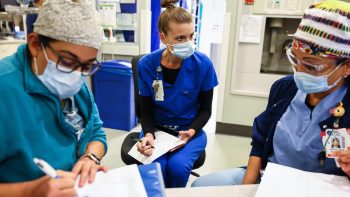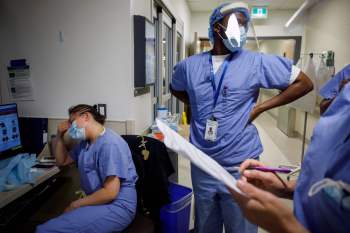Health companies eye predictive software for patient care
Pharmacy giant Walgreens recently announced it has begun using predictive software to help guide patient treatment. It’s just one of the latest efforts where healthcare hopes to standardize day-to-day operations.
With estimates that hundreds of billions of dollars is wasted every year on redundant or inefficient services, many industry leaders think healthcare needs to be more like Burger King, where a sandwich in Santa Fe tastes a lot like the sandwich in Seattle.
For some the path to slowing health costs may mean medical care has to look more like factory work.
As far as Walgreens executives are concerned, they think they may be on to something. The pharmacy chain is working with the IT firm Inovalon which, using data from more than 100 million patients, has developed algorithms to predict health problems.
Heather Helle who oversees Walgreen’s clinic business, says that data helps guide a nurse practitioner during a patient’s visit.
“You can think about it almost like a decision where if the answer to a particular question is ‘no,’ the system will guide the nurse practitioner down one particular path,” she says. “If the answer to a particular question is ‘yes,’ the system will intelligently guide the nurse practitioner down the second path.”
Let’s say a patient’s record shows he’s got multiple symptoms for diabetes but no official diagnosis. The computer flags that, and the Walgreens nurse practitioner zeros right in.
“We are able to streamline the visit, we’re able to reduce variation and we are able to deliver incredible value,” she says.
Whether it’s this predictive modeling, patient safety protocols at Johns Hopkins, or a Camden doctor’s office using new scheduling techniques, many in healthcare say the industry must industrialize. This may sound like some healthcare version of painting by numbers, and former Denver Health CEO Patricia Gabow says executives can over do it when it comes to standardizing care.
“It’s not just any routine, could be a routine that’s very wasteful. Or a routine that doesn’t yield high quality,” she says.
Another concern is if the rules are too rigid, patient care could suffer. But right now, Harvard Business School Professor Clayton Christensen says a lack of doctor routines is threatening patient safety and driving up costs.
Routines – like Walgreen’s algorithms – may sound scary, says Christensen, but they are really just a way of sharing decade’s worth of doctor’s knowledge with people you don’t have to pay like doctors.
“Nurse practitioners can do even more consistently what doctors do today,” he says.
Christensen says healthcare costs will go down as lower-cost caregivers do more and more.
There’s a lot happening in the world. Through it all, Marketplace is here for you.
You rely on Marketplace to break down the world’s events and tell you how it affects you in a fact-based, approachable way. We rely on your financial support to keep making that possible.
Your donation today powers the independent journalism that you rely on. For just $5/month, you can help sustain Marketplace so we can keep reporting on the things that matter to you.


















